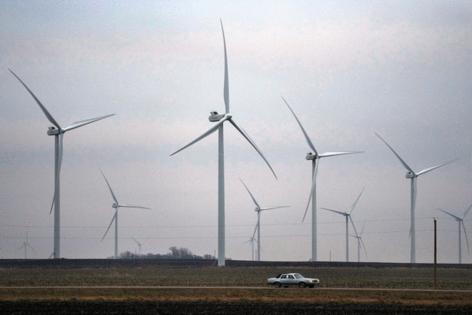In Minnesota farm country, a plan for a $4 billion data center takes root with vast wind, solar and battery projects
Published in Science & Technology News
WORTHINGTON, Minn. — A power developer has a novel plan to build a $4 billion data center in rural southwestern Minnesota, as well as an armada of wind, solar and battery plants the company hopes will attract a wealthy buyer.
Somewhere among the farm fields that dominate the landscape around the tiny enclaves of Brewster and Reading, Geronimo Power envisions a project that could eventually use as much electricity as roughly 1 million homes — dwarfing other data centers proposed in Minnesota.
The development would be remarkable for its rural location, its size and Geronimo’s idea to bundle clean power with a data center.
The plan also reflects how Minnesota’s energy sector is changing at a breathtaking pace, and the lengths businesses, local governments and electricity providers will go for a piece of the volatile but lucrative artificial intelligence industry.
The data center might never happen. Geronimo hasn’t cleared the most important hurdle: persuading a U.S. tech giant such as Google, Amazon or Apple to buy the data center and renewable energy.
Geronimo’s plan has also been met with mixed feelings in the epicenter of Minnesota’s renewable power sector, where some bristle at the idea of turning more corn and soybean fields into wind and solar installations.
Geronimo and the small Nobles Cooperative Electric hope to win over skeptics by pitching themselves as responsible and transparent while building a more environmentally friendly data center that would usher in a once-in-a-generation economic transformation.
“Nobles County will never see anything like this again, ever, I don’t believe,” said Adam Tromblay, CEO and general manager for the cooperative. “We’re dying communities down here, and we’re going to be able to bring so much life and vitality into these places with these good jobs.”
Bloomington-based Geronimo’s main business is building renewable power. The idea for a data center came as more large tech companies, with ambitious goals to reduce their carbon footprint, signed up to buy Geronimo’s clean energy, said president Blake Nixon.
Energy demand has spiked with the growth of cloud computing services and AI. For Geronimo, that’s what makes selling new clean power with a data center a potentially attractive option for tech companies.
Geronimo would develop the data center complex in phases through the early 2030s. It would start with $4 billion campus, and then hopes to add an estimated $6 billion development later on. The company would build three wind and battery projects, as well as a solar and battery farm to help power the data center.
Minnesota has no large-scale data centers yet, but developers have proposed more than a dozen. Most are in the suburbs of Minneapolis and St. Paul. Meta, the parent company of Facebook and Instagram, is building the state’s first large-scale data center in Rosemount.
Some data center projects have been controversial for their potential electricity use, water consumption and secrecy.
Geronimo says its project would use a minimal amount of water for cooling. The company has not asked local governments to sign nondisclosure agreements. Geronimo also hopes its clean energy plans will help reduce the concerns of environmental advocates who fear the data center boom will threaten Minnesota’s climate goals.
One reason Geronimo wants to build in southwestern Minnesota is to use up cheap surplus wind power that is now wasted because of limited capacity on power lines.
Geronimo estimates the data center would create about 1,000 construction jobs, as well as roughly 180 full-time jobs to operate. It could bring in tens of millions of dollars every year in local tax revenue, said Jordan Burmeister, Geronimo’s senior director of development.
Tromblay said a data center would allow the cooperative to improve its infrastructure with new projects such as burying power lines, and he said the income would help stabilize electric rates for other customers.
It’s unclear if that will be enough to win trust in local communities.
Southwestern Minnesota is already home to wind farms and is a growing hub of solar production. Geronimo’s three wind projects would cover 100,000 acres.
The Fultz family farms corn, soybeans and pigs in southwestern Minnesota and plans to host wind turbines for the Plum Creek project tied to the data center.
Eric Fultz worries that building so much new renewable power will lead to higher electric bills, and he questioned whether the grid will be reliable. Still, several family members said the prevailing view in the area is that wind, solar and data centers are inevitable as the economy changes, even if not everyone is thrilled with the industries.
Eric’s brother Denny said income from the turbines will be a “nice little bonus” when income from farming fluctuates.
“This area has got three big natural resources,” Denny Fultz said in an interview at the family’s shop office in Tracy, Minn. “Black dirt with plenty of moisture to grow good crops. It has the sun and the wind. Until 20 years ago, we were only using the one natural resource, the black dirt.”
Geronimo’s Summit Lake solar and battery project has upset many in and around Reading, Minn., because the panels would surround some houses and crowd the town’s borders.
Debra Rogers is one of a handful of landowners who wrote to state utility regulators earlier this year, asking them to reject the Summit Lake plan.
Under Geronimo’s initial proposal, solar panels would have covered the farm land on three sides of Rogers’ home, where she has lived since 1990 and raised three children.
Rogers said she loves the quiet, rural character of area. She has a view now of maple trees in her front yard, a playset for her grandchildren and rows of crops that stretch to the horizon. She wonders if deer and other wildlife that roam her property will disappear if solar is built.
Rogers said she doesn’t bring up the solar project in the community, because not everyone sees it the same way.
“I just feel if this does go through, it’s going to cause friction between neighbors and friends,” Rogers said.
Geronimo says it’s redesigning the layout of the solar farm after local frustration.
Local buy-in is not the only challenge for Geronimo.
One is whether the cooperative can handle such a large customer. The data center could eventually use about 27 times more electricity than Nobles’ entire system.
“We’re this little $23 million-a-year co-op,” Tromblay said. “I’m going to be asking (a data center company) for hundreds of millions of dollars in deposits because I don’t have that cash.”
The rural location also presents unique challenges.
Most data centers are near population hubs. That helps reduce latency for services like streaming video, said Andy Cvengros, co-leader of the data center markets team for real-estate firm Jones Lang LaSalle.
Proximity to cities is less important for sites focused on artificial intelligence, he said. But there are limits.
“You go build a 20-building, gigawatt campus in the middle of nowhere, where are those people going to stay?” Cvengros said. “Are there hotels? Are there restaurants? Do they have to drive two hours to work every day back and forth?”
Back in Tracy, a white stake marks the site of one turbine in a field of black soil that, after a recent rainfall, cakes boots like cement. The stake is a sign of economic promise in the region but also the speculative nature of the power industry and the changing market.
The Plum Creek wind farm hasn’t come to fruition since it was proposed nearly a decade ago. “Electricity was going to the metro,” Eric Fultz said about the original wind farm pitch.
He knows that project timelines and business strategies don’t always turn out as first envisioned. But, he added: “It’s a little frustrating.”
_____
©2025 The Minnesota Star Tribune. Visit at startribune.com. Distributed by Tribune Content Agency, LLC.







Comments